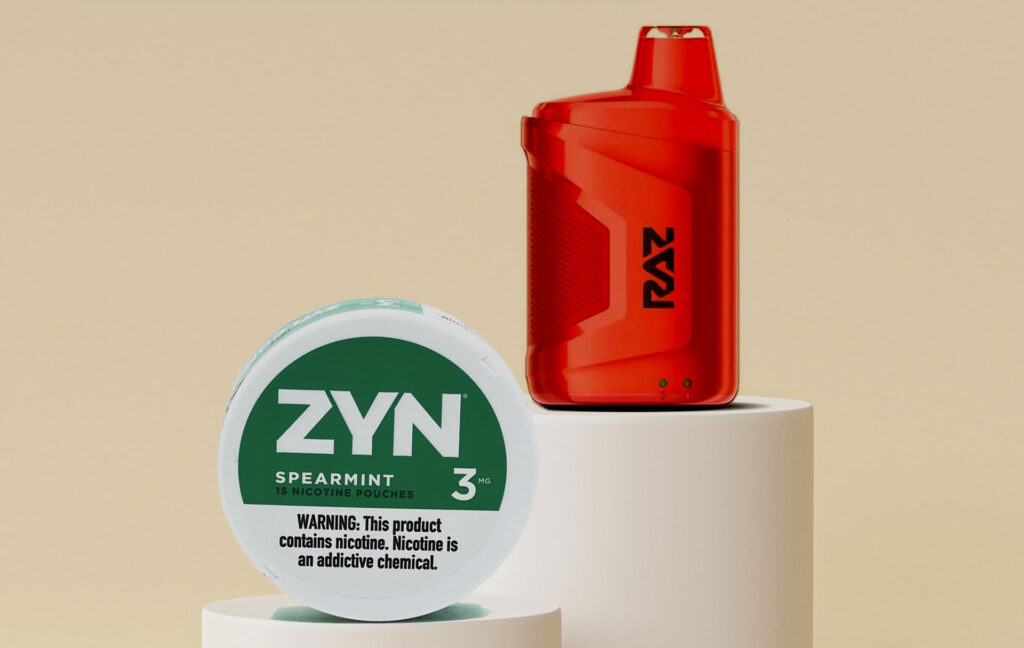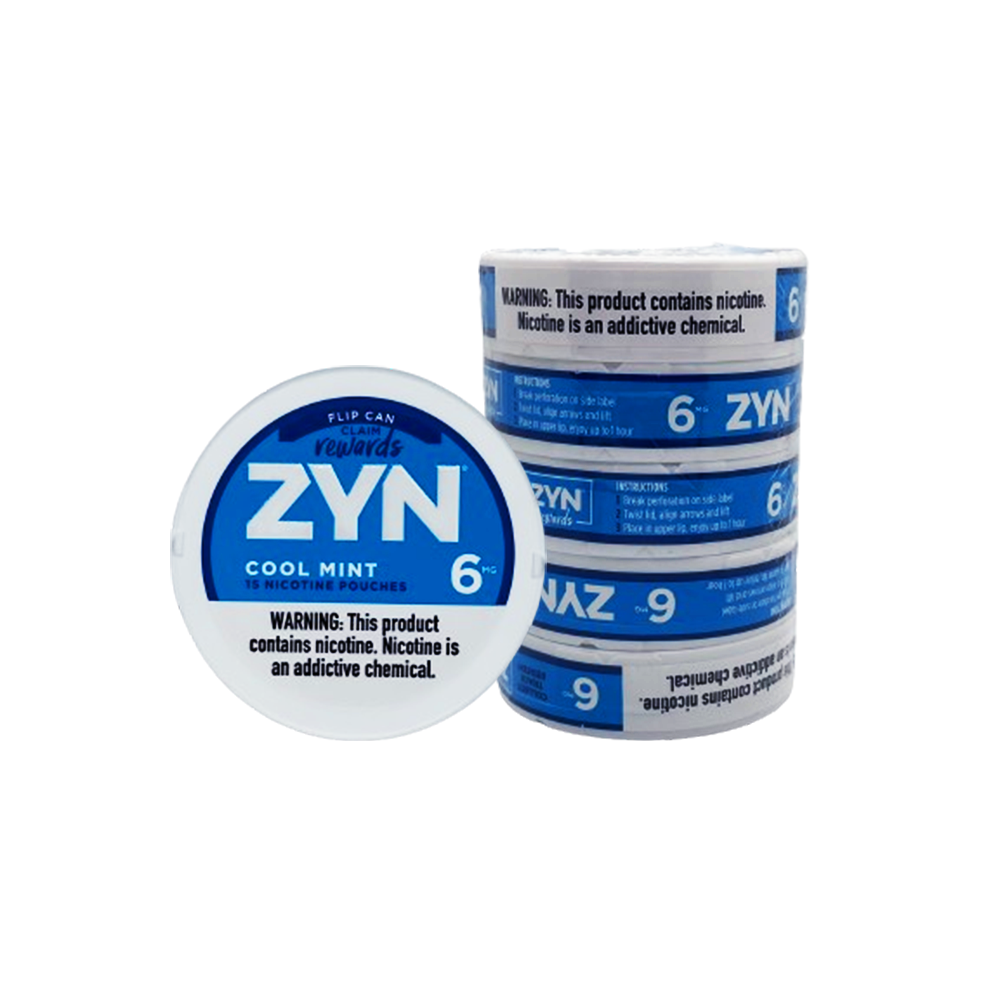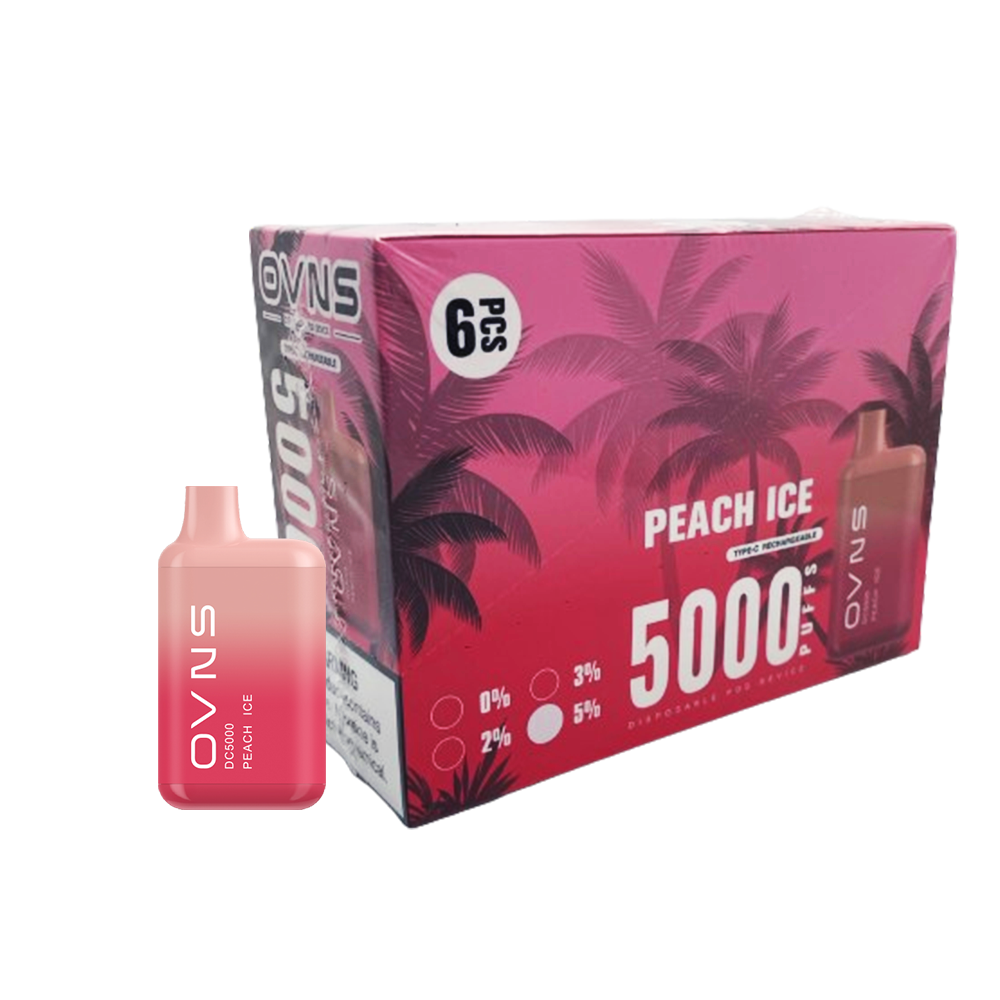What Is Vaping?
Vaping is a modern method of consuming nicotine (or non-nicotine substances) through an electronic device known as a vaporizer, or vape. The device heats a liquid, commonly referred to as e-liquid or vape juice, into a vapor, which the user inhales.
A typical vape device consists of:
- A battery to power the device.
- A heating element (also called a coil) that heats the liquid.
- A tank or pod that holds the e-liquid.
- A mouthpiece through which the vapor is inhaled.
The e-liquid used in vaping devices usually contains a mix of ingredients such as nicotine, propylene glycol (PG), vegetable glycerin (VG), and flavorings. The nicotine content can vary, giving users a range of options to suit their needs.
The variety in vaping devices is vast, ranging from simple, disposable e-cigarettes to advanced mods that allow for adjustments in power, airflow, and even temperature, offering a more customizable experience.
What Are Nicotine Pouches?
Nicotine pouches, on the other hand, are oral nicotine products that come in small, discreet pouches resembling tiny tea bags. These pouches are placed between the user’s gum and lip, where the nicotine is absorbed through the lining of the mouth.
Unlike traditional smokeless tobacco products like chewing tobacco or snus, nicotine pouches typically do not contain tobacco. Instead, they deliver nicotine through a combination of food-grade fillers, nicotine salts, flavorings, and sometimes sweeteners. They are available in a variety of flavors and nicotine strengths, catering to a wide range of users.
Because nicotine pouches don’t require combustion, they are considered a “cleaner” form of nicotine consumption. There’s no smoke, vapor, or smell, which makes them a popular option for people looking for discretion and convenience.

Ingredients in Vaping vs. Nicotine Pouches
One of the biggest differences between vaping and using nicotine pouches lies in the ingredients they use. Understanding these ingredients is crucial to grasp the overall safety and experience provided by each method.
Ingredients in Vaping:
- Propylene Glycol (PG): A common food additive that is used as a carrier for flavors and nicotine. It provides a stronger throat hit, which mimics the feeling of smoking.
- Vegetable Glycerin (VG): A thick, sweet liquid that helps produce large vapor clouds and provides a smoother inhale.
- Nicotine: Derived from the tobacco plant or synthesized in labs, nicotine is the primary addictive substance in vape juice. E-liquids come in varying nicotine concentrations, often measured in milligrams per milliliter (mg/ml).
- Flavorings: Vaping offers an enormous variety of flavors, from traditional tobacco and menthol to fruity, dessert, and even beverage-inspired options. These flavorings are usually food-grade but can vary in quality.
Products such as: OVNS 5000 Vapes
Ingredients in Nicotine Pouches:
- Nicotine Salts: Instead of freebase nicotine, nicotine pouches often contain nicotine salts, which are more stable and can be absorbed more easily through the mucous membranes.
- Fillers: These are used to bulk up the pouch and typically include plant-based or food-grade fillers such as cellulose.
- Flavorings and Sweeteners: Like vape liquids, nicotine pouches also come in various flavors, though the variety is often less extensive than vape flavors. Common flavors include mint, citrus, and coffee, and the sweetness may be adjusted with non-caloric sweeteners.
Products such as: Zyn Nicotine Pouches
Delivery Mechanism: How Nicotine Is Absorbed
Another major point of difference between vaping and using nicotine pouches is how nicotine is absorbed into the body.
Vaping Nicotine Absorption:
When you vape, the liquid in your vape device is heated to create vapor, which is then inhaled into your lungs. The nicotine in the vapor is absorbed through the lungs’ alveoli, small air sacs where gas exchange occurs. This provides a quick delivery of nicotine into the bloodstream, which is why many people feel the effects of vaping almost immediately after inhaling.
The fast absorption of nicotine through vaping mimics the nicotine delivery from smoking a cigarette. This makes vaping a popular choice for those transitioning from smoking, as it can satisfy nicotine cravings rapidly.
Nicotine Pouch Absorption:
Nicotine pouches, on the other hand, rely on a different delivery system. Instead of being inhaled, the nicotine is absorbed through the mucous membranes in your mouth. The pouch is placed between the lip and gum, and the nicotine diffuses slowly into the bloodstream.
The nicotine release from pouches is more gradual compared to vaping. It typically takes a few minutes to feel the effects, and the release is steady for as long as the pouch is in place (usually around 30-60 minutes).
Taste, Flavor, and Experience
When it comes to taste and overall experience, vaping and nicotine pouches offer distinct sensations. The user experience for each is shaped by the way these products interact with the senses.
Vaping Experience:
Vaping is often regarded as a sensory experience. The flavors of e-liquid can be rich and varied, from fruity and sweet to savory and complex. The act of inhaling vapor also simulates the familiar hand-to-mouth motion that cigarette smokers often miss, which is why vaping is such a popular alternative to smoking.
- Flavor intensity: Vaping delivers a strong flavor profile with each inhale. Whether you prefer menthol, dessert-like flavors, or fruity options, the flavor intensity is usually quite prominent.
- Vapor production: For some users, creating large clouds of vapor is an enjoyable part of the experience, making vaping not only a nicotine delivery method but also a social activity or hobby. Devices like sub-ohm tanks allow for bigger clouds and more flavor saturation.
- Throat hit: Nicotine concentration and the blend of PG/VG in the e-liquid can affect the “throat hit,” or the sensation at the back of the throat when inhaling. A higher PG blend delivers a stronger hit, while a higher VG ratio provides a smoother, softer sensation.
Nicotine Pouch Experience:
Using nicotine pouches is a much subtler experience. There is no vapor or smoke, so the oral sensation is the primary focus. The flavors are more understated compared to vaping, and since the pouch stays in one spot, the taste does not evolve or change much over time.
- Flavor options: While not as extensive as vaping, nicotine pouches do come in popular flavors such as mint, citrus, and berry. The flavor is released slowly and remains consistent while the pouch is in place.
- Discreetness: One of the key appeals of nicotine pouches is their discretion. There’s no visible vapor, no smell, and no hand-to-mouth motion, making them an ideal choice for situations where smoking or vaping might not be socially acceptable.
Convenience and Portability
Both vaping and nicotine pouches offer users a more convenient alternative to traditional smoking, but the two differ significantly in terms of portability and ease of use.
Vaping:
- Device maintenance: Vape devices can require some upkeep. Recharging batteries, refilling tanks, or replacing pods, as well as changing coils, are part of the experience for regular vapers. Advanced vape devices may also need to be cleaned to maintain performance.
- Portability: While many vape devices are designed to be portable, they can vary in size. Larger vape mods with bigger batteries and tanks are bulkier, while smaller pod systems and disposables are easier to carry around. However, even with compact vapes, you may need to carry extra liquid, chargers, or spare parts.
- Usability: Vaping involves pressing buttons, adjusting settings, and sometimes waiting for the device to heat up. While it’s not overly complicated, it can be less convenient than nicotine pouches, especially for people who are constantly on the go.
Nicotine Pouches:
- No maintenance: Nicotine pouches are as simple as it gets. There’s no need for charging or refilling. Once you’re done with a pouch, you simply discard it.
- Portability: Nicotine pouches come in small cans that fit easily in a pocket or bag. You don’t need to carry extra accessories, which makes them more convenient when traveling or during activities like hiking or sports.
- Discreet use: Since there’s no visible vapor or smoke, nicotine pouches can be used discreetly in public places, including indoor settings where vaping or smoking might not be allowed.
Health Considerations
When choosing between vaping and nicotine pouches, health is often a top concern. It’s important to note that both methods are designed to be less harmful than traditional smoking, but they still come with their own risks.
Vaping Health Considerations:
Vaping is widely regarded as a less harmful alternative to smoking, primarily because it avoids the combustion of tobacco, which produces harmful tar and carcinogens. However, there are still health concerns surrounding vaping:
- Lung health: Inhaling vapor, particularly if it contains harmful additives like vitamin E acetate (which has been linked to lung issues), can irritate or damage the lungs over time. While the long-term effects of vaping are not fully known, certain chemicals in vape liquid may have health risks.
- Nicotine addiction: Vaping still delivers nicotine, which is highly addictive. For people who are not already addicted to nicotine, vaping can lead to dependency.
Nicotine Pouches Health Considerations:
Nicotine pouches, because they are not inhaled, eliminate the lung-related risks associated with vaping or smoking. They don’t produce smoke or vapor, so there is no exposure to secondhand smoke or harmful particulates.
However, there are still potential health risks:
- Oral health: Prolonged use of nicotine pouches could lead to gum irritation or other oral health issues. Users should be cautious about prolonged contact with the gums.
- Nicotine addiction: Like vaping, nicotine pouches contain nicotine, which is addictive. Users may find themselves using pouches more frequently, especially with higher nicotine concentrations.
User Preferences and Social Perception
The choice between vaping and nicotine pouches can also come down to personal preferences and how each method fits into your lifestyle and social environment.
Vaping Social Perception:
Vaping is often more visible and noticeable than nicotine pouches. The production of large clouds of vapor can make it a social activity in certain settings, but it can also draw unwanted attention in more formal or professional environments. For this reason, vaping may not be suitable for every situation.
However, for those who enjoy the ritual of smoking or vaping, the hand-to-mouth action, the visual experience of exhaling vapor, and the range of flavors make vaping a compelling alternative to smoking.
Nicotine Pouch Social Perception:
Nicotine pouches, being almost invisible when used, are incredibly discreet. They can be used in social or professional settings without drawing attention, making them a preferred choice for people who need a nicotine fix without the social stigma associated with smoking or vaping.
Pouches are often seen as a cleaner, more convenient option, particularly for people who are health-conscious or want to avoid the noticeable by-products of vaping like vapor or scent.
Which Is Right for You?
The choice between vaping and nicotine pouches boils down to your personal preferences, lifestyle, and specific needs. Let’s break it down:
- If you enjoy flavor variety: Vaping is the clear winner, offering hundreds of e-liquid flavors and customizable experiences.
- If you want a discreet option: Nicotine pouches are more convenient and less noticeable, making them ideal for those who want to consume nicotine without drawing attention.
- If you prefer something fast-acting: Vaping provides quick nicotine delivery similar to smoking, which might be preferable if you need immediate satisfaction for cravings.
- If you want a low-maintenance option: Nicotine pouches are much simpler, requiring no charging, refilling, or cleaning.
- If you’re concerned about lung health: Nicotine pouches avoid inhalation altogether, which might appeal to those worried about the potential risks of inhaling vapor.
Conclusion
Vaping and nicotine pouches offer two very different approaches to nicotine consumption, each with its unique benefits and drawbacks. Vaping provides a more sensory, flavorful, and customizable experience, but it requires maintenance and is less discreet. Nicotine pouches, on the other hand, are incredibly convenient, discreet, and portable but don’t offer the same richness in flavor or fast nicotine delivery as vaping.
Ultimately, the decision comes down to your personal needs—whether you prioritize convenience, discretion, flavor, or health concerns. Both options offer a modern, potentially less harmful alternative to traditional smoking, giving you the freedom to choose the method that best fits your lifestyle.




